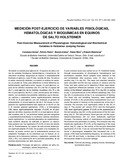Mostrar el registro sencillo del ítem
Medición post-ejercicio de variables fisiológicas, hematológicas y bioquímicas en equinos de salto holsteiner
| dc.rights.license | http://creativecommons.org/licenses/by-nc-sa/3.0/ve/ | |
| dc.contributor.author | Gómez, Constanza | |
| dc.contributor.author | Petrón, Patricio | |
| dc.contributor.author | Andaur, Marcela | |
| dc.contributor.author | Pérez, Rubén | |
| dc.contributor.author | Matamoros, Roberto | |
| dc.date.accessioned | 2009-05-07T14:35:56Z | |
| dc.date.available | 2009-05-07T14:35:56Z | |
| dc.date.issued | 2009-05-07T14:35:56Z | |
| dc.identifier.issn | 0798-2259 | |
| dc.identifier.uri | http://www.saber.ula.ve/handle/123456789/28107 | |
| dc.description.abstract | Se realizó un estudio post-ejercicio en 10 equinos de salto a través de variables fisiológicas, hematológicas y bioquímicas. Se obtuvieron muestras sanguíneas en reposo e inmediatamente finalizado el ejercicio, cada 15 días, durante 60 días. Se obtuvo la media, desviación estándar y se realizó un análisis de varianza y la prueba de Tukey para determinar si existe diferencia estadísticamente significativa entre: reposo v/s post-ejercicio; reposo de los distintos muestreos (día 15 a día 60) v/s reposo del día 0 y post-ejercicio de los distintos muestreos (día 15 a día 60) v/s post-ejercicio del día 0, como consecuencia del entrenamiento. Los resultados han permitido determinar que la frecuencia cardíaca y respiratoria fueron significativamente menores (P<0,05) en el post-ejercicio una vez finalizado el período de entrenamiento v/s el post-ejercicio del día 0. Así mismo, la recuperación fue significativamente más rápida en el día 60 v/s día 0. El volumen globular aglomerado (VGA) y la hemoglobina (HB) fueron significativamente mayores (P<0,05) en el postejercicio del último muestreo (día 60) v/s el post-ejercicio del primer muestreo (día 0). Las proteínas totales, glucosa sanguínea y aspartatoaminotransferasa no mostraron cambios estadísticamente significativos. La actividad plasmática de creatinfosfoquinasa aumentó después de realizado el ejercicio v/s reposo. Este aumento solo fue significativo (P<0,05), al inicio del estudio (día 0). Posteriormente, los valores de esta enzima disminuyeron significativamente (P<0,05). De acuerdo a los resultados obtenidos, se puede concluir que el entrenamiento produce una adaptación fisiológica de los individuos que se traduce en un descenso de la frecuencia cardíaca y respiratoria, aumento del VGA y HB y una disminución de la actividad plasmática de las enzimas relacionadas con daño muscular. | es_VE |
| dc.rights | info:eu-repo/semantics/openAccess | |
| dc.subject | Fisiología del ejercicio | es_VE |
| dc.subject | Caballos de salto | es_VE |
| dc.subject | Hematología | es_VE |
| dc.subject | Valores bioquímicos | es_VE |
| dc.title | Medición post-ejercicio de variables fisiológicas, hematológicas y bioquímicas en equinos de salto holsteiner | es_VE |
| dc.title.alternative | Post-exercise measurement of physiological, hematological and biochemical variables in holsteiner jumping horses | es_VE |
| dc.type | info:eu-repo/semantics/article | |
| dc.description.abstract1 | A post-exercise study was carried out on 10 Holsteiner horses through measurements of physiological, hematological and biochemical variables. Blood samples were obtained at rest and immediately after exercise, every 15 days, during 2 months (day 0 to day 60). The mean and standard deviation were calculated and the two-way analysis of variance and the Tukey test were carried out to determine if there were statistically significant differences between at rest v/s postexercise; resting at the different samplings (day 15 to day 60) v/s resting at day 0 and postexercise at the different samplings (day 15 to day 60) v/s postexercise at day 0, as consequence of training. The heart rate and breathing frequency were significantly smaller (P<0.05) in the postexercise measurement once concluded the period of training v/s the postexercise at the day 0. Likewise, the recovery was significantly faster at day 60 v/s days 0. The packed cell volume (PCV) and the hemoglobin (HB) were significantly greater (P<0.05) at the postexercise of the last sampling (day 60) v/s the postexercise of the first sampling (day 0). The total proteins, blood glucose and the aspartateaminotransferase did not show statistically significant changes. The plasma activity of creatinkinase increased after the exercise was performed v/s resting. This increase was only statistically significative (P<0.05), at the beginning of the study period (day 0). Later on, the activity of this enzyme diminished significantly (P<0.05). It can be concluded that the training produced a physiological adaptation that translated into a decrease of the heart and breathing frequency, an increase of the PCV and HB and finally, a decrease of the plasma activity of the enzymes related to muscular damage. | es_VE |
| dc.description.colacion | 244 - 253 | es_VE |
| dc.description.frecuencia | Bimestral | |
| dc.identifier.depositolegal | 199102ZU46 | |
| dc.subject.institucion | Universidad del Zulia (LUZ) | es_VE |
| dc.subject.institucion | Universidad de Los Andes (ULA) | es_VE |
| dc.subject.keywords | Exercise physiology | es_VE |
| dc.subject.keywords | Jumping horses | es_VE |
| dc.subject.keywords | Hematology | es_VE |
| dc.subject.keywords | Biochemical values | es_VE |
| dc.subject.publicacionelectronica | Revista Científica | |
| dc.subject.tipo | Revistas | es_VE |
| dc.type.media | Texto | es_VE |
Ficheros en el ítem
Este ítem aparece en la(s) siguiente(s) colección(ones)
-
Revista Científica - 2004 - Vol XIV - No. 003
mayo - junio



